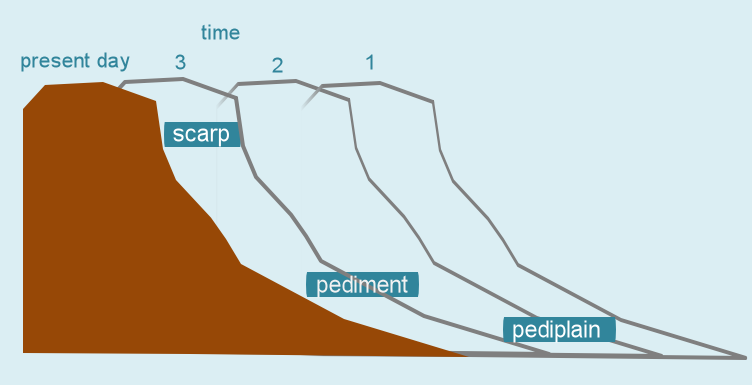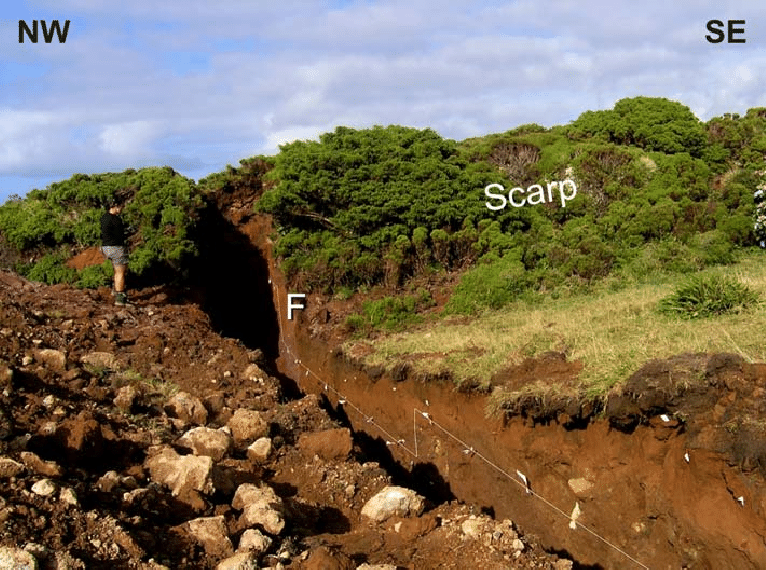How Scarp Retreat Causes the Development of Canyon Landscapes

How Scarp Retreat Causes the Development of Canyon Landscapes:
Scarp Retreat Causes the Development of Canyon Landscapes through the gradual erosion and removal of softer rock layers that lie beneath harder, more resistant rock strata. This geological process, influenced heavily by water erosion, leads to the formation of steep-sided valleys and canyons, which are iconic features of canyon landscapes.

Scarp Retreat is a geological process where the edges of a plateau or elevated land area gradually move backward over time due to erosion. This erosion, mainly caused by water, wears away the softer rock layers beneath the harder, more resistant rock surfaces, forming steep cliffs or scarps. As these scarps are eroded at their base, the harder rock can collapse and move back, leading to the expansion of valley or canyon landscapes beneath them.
Erosion and Weathering
At the heart of scarp retreat is the interaction between erosion and weathering. Rainwater, especially acidic rain, can dissolve certain types of rock, while physical weathering can cause rocks to break down into smaller pieces. Over time, rivers and streams flowing over the landscape exploit these weaknesses, eroding the softer rock more quickly than the harder rock. This differential erosion creates the characteristic steep cliffs, or scarps, of a canyon.
Differential Erosion
Differential erosion plays a critical role in shaping canyon landscapes. Harder rock layers resist erosion, forming the canyon’s rim, while softer rock layers are eroded away more easily, deepening the canyon over time. The result is a dramatic landscape of high cliffs and deep valleys. The Grand Canyon in the United States is a classic example of a landscape shaped significantly by differential erosion.
Role of Water Flow
The flow of water is the driving force behind scarp retreat. As rivers cut through the landscape, they not only deepen their beds but also undermine the base of the scarp, causing portions of the harder rock layer to collapse and retreat backward. This process of undercutting and collapse continues over millions of years, gradually moving the scarp line back and enlarging the canyon.
Climate Impact
The rate of scarp retreat is significantly influenced by climate. In areas with heavy rainfall, erosion is accelerated, leading to faster retreat of the scarp and more rapid development of the canyon landscape. Conversely, in arid regions, where water is scarce, scarp retreat occurs more slowly, though even here, flash floods can cause significant erosional events that rapidly reshape the landscape.
In summary, the development of canyon landscapes through scarp retreat is a testament to the power of natural processes. It illustrates the interplay between geological materials, the erosive force of water, and the influence of climate, creating some of the most spectacular and iconic landscapes on our planet.
FAQs
In which landscape is scarp retreat common?
Scarp retreat is commonly observed in landscapes characterized by plateaus, highlands, and areas with significant hard rock layers overlaying softer rock layers. These settings provide the perfect conditions for scarp retreat to occur, leading to the formation of steep cliffs and canyons.
In these landscapes, the differential erosion plays a critical role. The harder rock layers resist erosion, creating a protective cap over the softer layers beneath. Over time, as the softer rock is eroded by elements like water and wind, the hard rock layers become undercut and eventually collapse, retreating backwards and shaping the landscape into steep, cliff-like features. This process is especially prominent in arid and semi-arid regions, where the lack of vegetation exposes the rock to direct erosion.
What is the meaning of scarp retreat?
Scarp retreat refers to the geological process where the edge of a steep slope, or scarp, moves backward due to the erosion of the land below the scarp face. This erosion is primarily caused by natural elements like water and wind.
Scarp retreat is an integral part of how landscapes evolve over time. It occurs as softer rock layers beneath harder, more resistant layers are worn away, leading to the eventual collapse of the unsupported harder layers. This process not only deepens valleys and canyons but also widens them, as the scarp’s edge moves back, creating dramatic and often vertical cliffs in the landscape.
What is the difference between a scarp slope and a dip slope?
A scarp slope is a steep or vertical face of rock, often forming the edge of a plateau or ridge, where the rock strata are exposed and decline steeply. In contrast, a dip slope is the gentler slope that occurs on the opposite side of a scarp, where the rock layers dip away from the escarpment at a much shallower angle.

The difference between these two types of slopes lies in their formation and angle of inclination. Scarp slopes result from the differential erosion of rock layers, where the harder layer forms the steep face as it resists erosion, while the softer layer underneath erodes more easily. Dip slopes, on the other hand, form on the side where the rock layers gently decline, following the natural angle of the strata. This creates a less steep slope and is often less affected by the process of erosion compared to scarp slopes.
What landscapes develop out of canyon landscapes?
Landscapes that develop out of canyon landscapes often evolve into complex river valleys and gorges, featuring mature river systems. Over time, as the river continues to erode the canyon floor and walls, the landscape can further diversify into a series of terraces, alluvial plains, and delta systems as sediment is deposited downstream. This evolution contributes to the creation of rich, varied ecosystems and can lead to the development of fertile lands along the riverbanks, supporting diverse flora and fauna.
The transformation from a canyon landscape to a more mature river valley landscape is a testament to the power of water in shaping the earth’s surface. As canyons widen and deepen, they may connect with other canyons or open into wider valleys, creating interconnected systems that drain large areas. These processes not only sculpt the physical landscape but also significantly influence the ecological and human dynamics of the region.
What are the characteristics of a canyon landscape?
The characteristics of a canyon landscape include steep-sided cliffs, narrow valleys, and significant depth compared to their width. Canyons often have a river running through them, which is the primary agent of erosion that deepens and shapes the canyon over time. The walls of canyons expose layers of earth’s history, showcasing sedimentary, metamorphic, and igneous rock formations.
Canyon landscapes are distinguished by their dramatic verticality and the stark contrasts between their deep shadows and sunlit edges, creating a unique and often breathtaking natural beauty. The ecosystem within a canyon can vary significantly from the rim to the floor, with different habitats corresponding to the changes in altitude, sunlight, and moisture levels. These landscapes are also characterized by their ability to support a diverse range of life forms, adapting to the specific conditions of the canyon environment.
What are the concepts of scarp retreat and back wasting?
Scarp retreat and back wasting are two interrelated concepts describing the erosion processes that shape steep landscapes, such as escarpments, cliffs, and canyons.
- Scarp retreat refers to the process where the edge of a steep slope or cliff gradually moves backward due to erosion at the base of the scarp. This occurs as softer rock layers beneath harder, more resistant layers are eroded away, causing the unsupported upper layers to collapse and the scarp to move back. Scarp retreat is a key factor in the widening of valleys and canyons, contributing to the development of dramatic vertical landscapes.
- Back wasting, on the other hand, describes the erosion of the face of a slope or cliff, leading to a reduction in the slope’s angle as material from the slope is worn away. This process can occur through various mechanisms, including physical weathering, chemical weathering, and the action of ice and water. Back wasting contributes to the gradual flattening of slopes and is often seen in conjunction with scarp retreat, as both processes work together to reshape landscapes over geological time scales.
Both scarp retreat and back wasting are crucial for understanding how landscapes are sculpted and transformed by natural forces, highlighting the dynamic and ever-changing nature of the earth’s surface.
What is an example of scarp in geology?
An iconic example of a scarp in geology is the Great Escarpment in Southern Africa. This significant geological feature stretches over 5,000 kilometers, running through South Africa, Namibia, Angola, and reaching into Zimbabwe. It forms a distinct boundary between the higher-lying interior plateau of the continent and the lower coastal plains. The Great Escarpment dramatically showcases how scarp landscapes can define regional topography, offering a clear example of a scarp’s impact on the landscape.

How are scarp slopes formed?
Scarp slopes are formed primarily through the process of differential erosion, where layers of harder rock resist erosion while underlying softer rock layers are more easily worn away. This can occur due to various factors, including water flow, wind, ice, and chemical weathering. Over time, as the softer rock is eroded, sections of the harder rock layer become unsupported and eventually collapse or break away, creating a steep, often abrupt slope known as a scarp.
Additionally, tectonic activity can also play a crucial role in the formation of scarp slopes. Earthquakes or movements along fault lines can uplift one section of land while leaving an adjacent section at a lower elevation, instantly creating a scarp. The subsequent erosion and weathering of these features further define their shape and steepness.
What does a scarp look like?
A scarp typically appears as a steep or nearly vertical slope or cliff, marking a sudden change in elevation between two level areas of differing heights. Scarps can range in height from a few meters to several hundred meters, creating dramatic features in the landscape. The face of a scarp is usually bare or sparsely vegetated due to the steepness, exposing the geological layers of the Earth’s crust.

In landscapes, a scarp can present a striking visual contrast, dividing flat or gently rolling terrain from higher plateaus or ridges. The appearance of a scarp can vary based on the type of rock that composes it and the erosional processes that shaped it, but it invariably stands out as a bold, defining feature of the topography, often offering breathtaking views and challenging terrain.
